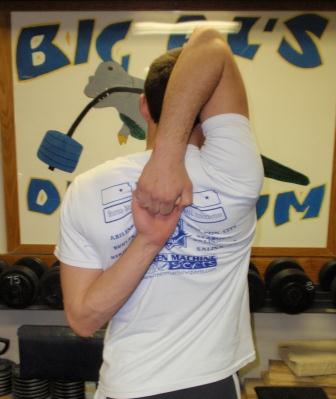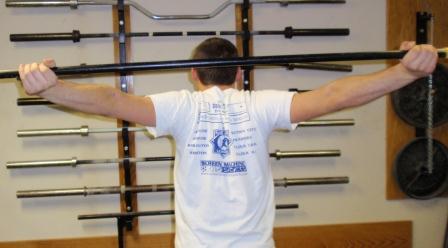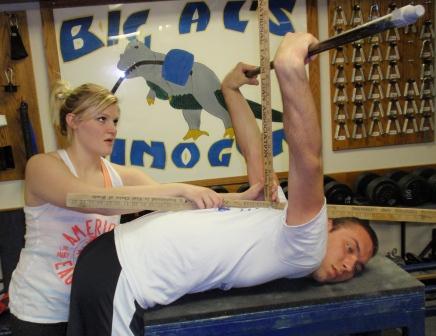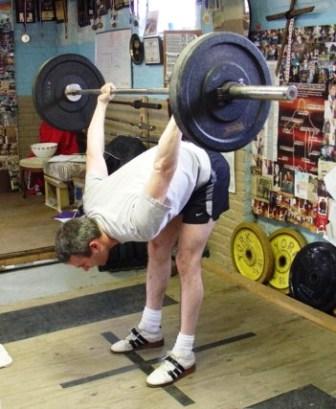Shoulder Flexibility Testing – Part 2
by Al Myers
I feel the following tests (listed below) do a good job of assessing your shoulder flexibility. I challenge everyone to take these tests yourself and then see if you have any flexibility issues with your shoulders. If you pass all of them with “flying colors” then I would say don’t worry about things at this time, you have more than enough shoulder flexibility to be a competitive weightlifter. Years ago when I was training young lifters for Olympic Lifting competitions I had a young girl miss one of her snatches in competition by getting the bar to far behind her head at the top of the snatch. She nonchalently performed a shoulder dislocation catching the bar behind her back without moving her hands, stood up, and then set the bar down on the platform behind her back. I was alarmed as I thought for sure she tore up her shoulders with this – but it didn’t faze her. She had such unbelievable shoulder flexibility that this was non painful in any way to her (even though it looked like it would have caused major injury to me!).
1. Shoulder Flex Test

Dino Gym member Bryce Meuli showing an excellent test on the Shoulder Flex Test. He easily made a full hand clasp both directions.
This is by far the most common test to assess shoulder flexibility. All it takes is a tape measure to evaluate the results. This test is widely used by personal trainers to evaluate clients before programs are established.
Instructions:
- Raise one arm over the head and reach downwards behind back
- Bend the other arm behind back and reach upwards
- Try to touch hands, and measure the distance apart if not touching
- Repeat with other direction
Shoulder Flex Test Results
EXCELLENT – fingers overlap
GOOD – fingers touch
AVERAGE – fingers are less than 2 inches apart
POOR – fingers are more than 2 inches apart
VERY POOR – fingers are more than 12 inches apart
EMBARRASSING – fingers are more than 24 inches apart
2. Shoulder Circumduction Test

Bryce was 12 inches beyond shoulder width in the Shoulder Circumduction Test. This would put him in the GOOD CLASSIFICATION.
This test measures the flexibility of shoulder rotation. It is also a very common test to evaluate shoulder flexibility. All that is required is a broomstick and a tape measure to measure results. The first thing you will need to do is measure the width of your shoulders at their widest point.
Instuctions:
- Hold broomstick overhead with straight arms with comfortable grip
- Lower the broomstick behind the head keeping the arms straight
- Slide your grip out on the broomstick to allow for shoulder rotation
- The entire hand must stay on the broomstick
- Once positioned above the hip, measure the distance between thumbs
Shoulder Circumduction Test Results
EXCELLENT – distance less than 6 inches more than shoulder width
GOOD – distance less than 12 inches more than shoulder width
AVERAGE – distance less than 18 inches more than shoulder width
POOR – distance less than 24 inches more than shoulder width
VERY POOR – distance less than 30 inches more than shoulder width
EMBARRASSING – distance more than 30 inches than shoulder width, or just can’t even do it!
3. Kelly Shoulder Stretch Test

Bryce scored an 85 degrees on the Kelly Shoulder Stretch Test. This would put him in the GOOD CLASSIFICATION. Of course if his assistant would have positioned the ruler a little more square on his back he would have been over the 90 degrees giving him an EXCELLENT RATING.
Now this is shoulder flexibility test that I came up with. It is a derivative of a not well-known All Round Lift – the Kelly Snatch (or also known as the reverse swing). It measures shoulder rotation from another direction. Instead of moving away from the head, you are moving towards the head with this test. It does take a little special equipment for measurement of this test. You will need a couple of small boards (like 3 foot rulers) bolted together, and a way of measuring degrees, as well as a broomstick.
Instructions:
- Place the hands shoulder width apart on a broomstick, palms up.
- Lay face down on a table with arms straight holding the broomstick above hips.
- Raise the broomstick up while keeping the arms straight
- Use rulers to fix angle at point of maximum rotation from center point of the shoulders
Kelly Shoulder Stretch Test Results
EXCELLENT – angle exceeds 90 degrees
GOOD – angle exceeds 75 degrees
AVERAGE – angle exceeds 60 degrees
POOR – angle exceeds 45 degrees
VERY POOR – angle exceeds 30 degrees
EMBARRASSING – angle is less than 30 degrees
How did you do on these simple shoulder flexibility tests? Are you excellent on all these tests? The purpose of this is to bring attention to any issues with poor shoulder flexibility, so you can take action to correct these deficiencies before things get worse. Because they will without attending to them!! Just a little work on shoulder flexibility might help in catching that Jerk or Push Press when over head with a maximum attempt, especially if you are at the low ends of these tests. I’m not going to “share with the World” my results, as so to say, THEY ARE EMBARRASSING!
